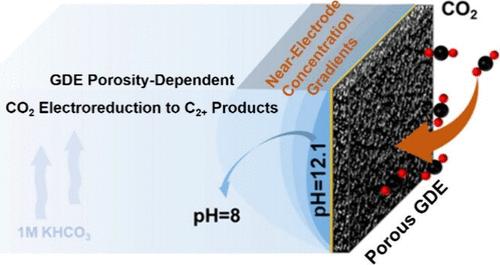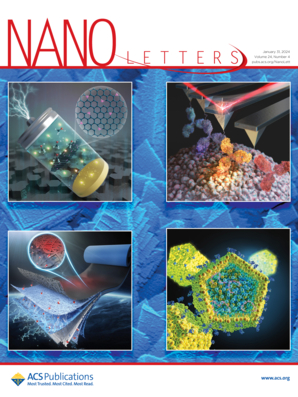优化选择性二氧化碳电还原成 C2+ 产物的多孔气体扩散电极内碳酸氢盐和 pH 值的近电极浓度梯度
IF 9.1
1区 材料科学
Q1 CHEMISTRY, MULTIDISCIPLINARY
引用次数: 0
摘要
在高电流密度下,强烈的近电极二氧化碳还原反应(CO2RR)会引起碳酸氢盐(HCO3-)和羟基(OH-)离子的浓度梯度,从而影响 CO2RR 高价值 C2+ 产物的选择性。在这项工作中,我们利用 COMSOL Multiphysics 模拟了不同多孔铜基 CL(催化剂层)的 GDE(气体扩散电极)电解质物种的近电极浓度梯度。孔隙率较高的 CL 对局部碱度具有更好的缓冲能力,同时确保 H+ 和局部 CO2 浓度的充足供应。随后,通过真空-热蒸发法制备了不同孔隙率的 CL,并采用了不同的蒸发速率。结构表征和液体渗透性测试证实了多孔 CL 结构在优化浓度梯度方面的作用。因此,在 1 M KHCO3 条件下,500 mA cm-2 时,高孔隙率 CL(Cu-HP)的 C2+ 法拉第效率(FE)为 79.61%,远高于低孔隙率样品(Cu-LP)的 FEC2+ ≈ 38.20%。本文章由计算机程序翻译,如有差异,请以英文原文为准。

Near-Electrode Concentration Gradients of Bicarbonate and pH within Porous Gas Diffusion Electrode for Optimized Selective CO2 Electroreduction to C2+ Products
With high current density, the intense near-electrode CO2 reduction reaction (CO2RR) will cause the concentration gradients of bicarbonate (HCO3–) and hydroxyl (OH–) ions, which affect the selectivity of high-value C2+ products of the CO2RR. In this work, we simulated the near-electrode concentration gradients of electrolyte species with different porous Cu-based CLs (catalyst layers) of GDE (gas diffusion electrode) by COMSOL Multiphysics. The higher porosity CL exhibits a better buffer ability of local alkalinity while ensuring a sufficient supply of H+ and local CO2 concentration. Subsequently, the different porosity CLs were prepared by vacuum-thermal evaporation with different evaporation rate. Structural characterizations and liquid permeability tests confirm the role of the porous CL structure in optimizing concentration gradients. As a result, the high-porosity CL (Cu-HP) exhibits a higher C2+ Faraday efficiency (FE) of ∼79.61% at 500 mA cm–2 under 1 M KHCO3, far more than the FEC2+ ≈ 38.20% with the low-porosity sample (Cu-LP).
求助全文
通过发布文献求助,成功后即可免费获取论文全文。
去求助
来源期刊

Nano Letters
工程技术-材料科学:综合
CiteScore
16.80
自引率
2.80%
发文量
1182
审稿时长
1.4 months
期刊介绍:
Nano Letters serves as a dynamic platform for promptly disseminating original results in fundamental, applied, and emerging research across all facets of nanoscience and nanotechnology. A pivotal criterion for inclusion within Nano Letters is the convergence of at least two different areas or disciplines, ensuring a rich interdisciplinary scope. The journal is dedicated to fostering exploration in diverse areas, including:
- Experimental and theoretical findings on physical, chemical, and biological phenomena at the nanoscale
- Synthesis, characterization, and processing of organic, inorganic, polymer, and hybrid nanomaterials through physical, chemical, and biological methodologies
- Modeling and simulation of synthetic, assembly, and interaction processes
- Realization of integrated nanostructures and nano-engineered devices exhibiting advanced performance
- Applications of nanoscale materials in living and environmental systems
Nano Letters is committed to advancing and showcasing groundbreaking research that intersects various domains, fostering innovation and collaboration in the ever-evolving field of nanoscience and nanotechnology.
 求助内容:
求助内容: 应助结果提醒方式:
应助结果提醒方式:


